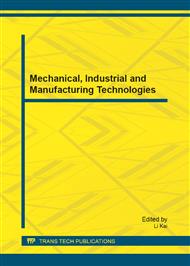[1]
Zhao Hou-Cai, The design and realization of regenerative braking system for electric vehicles based on DSP, Guangdong University of Technology . 2007, pp.11-13.
Google Scholar
[2]
Liu Bo, Research and implementation of braking-energy recovery system based on pure electric vehicle, Tsinghua University. 2004, pp.23-29.
Google Scholar
[3]
Zhang Pei-Bin, Research and simulation of electric vehicle's regenerative braking control, WuHan University of Technology. 2006, pp.21-22.
Google Scholar
[4]
Wang Kui, Development of Control strategy and software for power train system of pure electric automobiles, TianJin University, 2004, pp.11-15.
Google Scholar
[5]
Xiao Jing-Yi, The electronic control system for electric vehicle, Beijing Jiaotong University, 2007, pp.35-40.
Google Scholar
[6]
Wu Ying-Jie, Wang Jun-Yan, Application of power feedback brake of brushless DC motor to electric vehicle, Journal of Shanghai Dianji University. 2006, 3(9), pp.52-55.
Google Scholar
[7]
He Ren, Hu Qing-Xun, Braking course of city bus with regenerative braking system, Journal of jiangsu university(natural science edition), 2005, 5(26), pp.389-392.
Google Scholar
[8]
Mehradad Ehsani, Yimin Gao, Sebastien E. Gay , Ali Emadi. Modern electric, hybrid electric, and fuel cell vehicles fundamentals, theory, and design, , China machine press. 2008, pp.18-25.
DOI: 10.1201/9781420037739
Google Scholar
[9]
Feri Yusivar, Kenji Uchida, Takahiro Kihara, Shinji Wakao, An anti oscillation strategy for the regenerative braking control of permanent magnet synchronous motor with insufficient load power consumption" , The 27the Annual Conference of the IEEE Industrial Electronics Society (IECON, 01), 2001, pp.1457-1461.
DOI: 10.1109/iecon.2001.975999
Google Scholar
[10]
Wu Qian-Kun, Study on some problems of single chip AC servo control system, Harbin University of Science and Technology , 2004, pp.35-47.
Google Scholar
[11]
Analog Devices. AD7862 datasheet. 1996, pp.1-16.
Google Scholar
[12]
Leng Zai-Xing, Ma Zhi-Yuan, Space vector field-weakening control of IPMSM drives, Micromotors Servo Technique. 2006, pp.11-14.
Google Scholar
[13]
Sang-Hoon Kim, Seung-Ki Sul, Voltage Control Strategy for maximum torque operation of an induction machine in the field weakening region,. IEEE Transactions on Industrial Electronics. 1994, pp.599-604.
DOI: 10.1109/iecon.1994.397845
Google Scholar
[14]
Bon-Ho Bae, Nitin Patel, and Steven Schulz, Seung-Ki Sul. New, Field weakening technique for high saliency interior permanent magnet Motor, IEEE, 2003, pp.898-904.
DOI: 10.1109/ias.2003.1257641
Google Scholar


